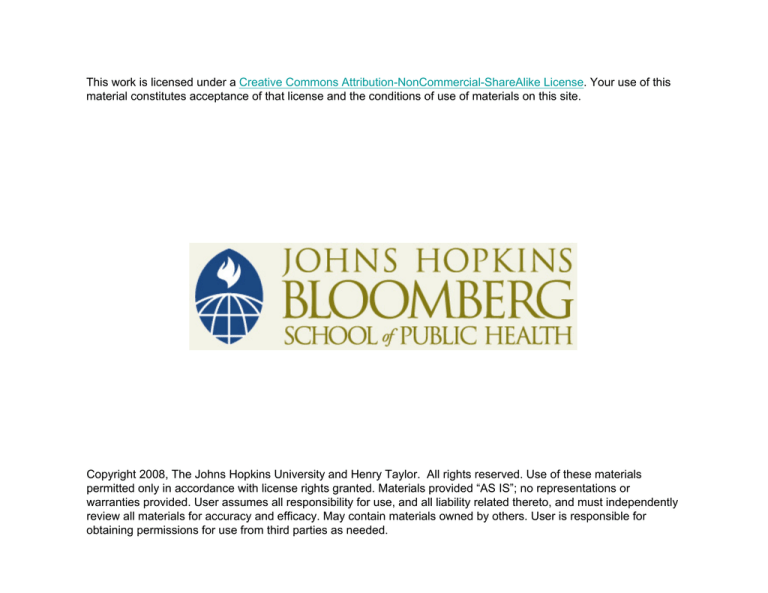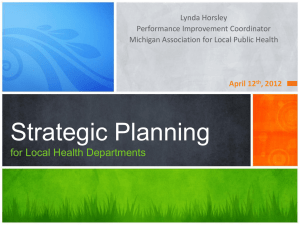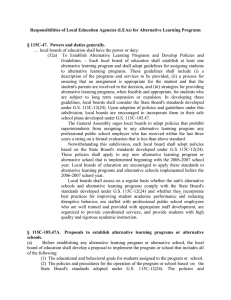
This work is licensed under a Creative Commons Attribution-NonCommercial-ShareAlike License. Your use of this
material constitutes acceptance of that license and the conditions of use of materials on this site.
Copyright 2008, The Johns Hopkins University and Henry Taylor. All rights reserved. Use of these materials
permitted only in accordance with license rights granted. Materials provided “AS IS”; no representations or
warranties provided. User assumes all responsibility for use, and all liability related thereto, and must independently
review all materials for accuracy and efficacy. May contain materials owned by others. User is responsible for
obtaining permissions for use from third parties as needed.
Public Health SYSTEM
Systems Thinking
The Intersectoral PH System
• Assurance of conditions for community health requires
coalition building
– Community
– Healthcare Delivery System
– Employers & Business
– Media
– Academia
– Governmental Public Health Infrastructure
• Click here to view a diagram from the IOM’s The Future
of the Public’s Health
Notes Available
Public Health As A System
• Public health is not a single product or service provided
by one type of professional
• It is a web of relationships between many people and
organizations about a wide variety of topics
• This web of relationships serves to assure conditions
that result in a healthy public
• The responsibility for assuring the health of the public
rests in specific agencies at different levels of
government
– local
– state
– federal and
– international
Notes Available
Public Health Structure
• Four governmental levels
– Local Health Departments
– State Health Agency
• Bureau for Public Health, Health Care Authority
– Federal Government
• CDC, HRSA, EPA, ?
– International Health Agencies
• WHO, UNICEF, etc
Notes Available
US Local Health Departments
(AGPALL)
• 2,864 Local Health Departments in the US
• 73% serve a county or combined city-county area
• 62% serve small jurisdictions (<50,000 popln)
– But they only account for 10% of the US population
• Most (54%) of the US population is served by the 6% of
LHDs serving populations of more than 500,000
– Largest is almost 10 million
• 12% LHD boundaries overlap with the boundaries of a
federally recognized tribal government
• States with “home rule” delegate particular constitutional
authority to counties and municipalities
Governance of Public Health in US
Boards of Health in US
• Forty states have local boards of health.
• 3,186 local boards identified by the CDC.
– 45.7% boards of health serve counties,
– 24.6% serve a town/city, and
– 29.7% serve other jurisdiction.
• 58% serve populations less than 25,000
• 74% LHD have Local Boards of Health
Governance & District Structures
• State Oversight of Local Health Departments
– 11 states (24.4%) LHD run by state health dept
– 10 states (22.2%) decentralized control to locals
– 24 states (53.5%) shared/mixed control
• 20 states (43.5%) have some district-level admin
– More in the Southern states (12 of 15)
Notes Available
State Health Agency
• The unit of government housing the State Health
Officer
• Federal funding often controls state activity
• US Constitution makes states responsible for the health
and safety of their citizens
• The “commerce clause” allows the federal government
to regulate interstate business
• National Security is Federal responsibility
Notes Available
State Health Officer Appointments
Appointed by:
1990
2001
– Governor
52.9%
68.1%
– Board of Health
2.0%
8.5%
– Superagency Director
7.8%
14.9%
– Other
37.3%
8.5%
Cabinet level position:
58.8%
53.2%
Required degree:
– Medical degree (MD or DO) 52.9%
44.4%
– MPH or MPA
2.0%
2.2%
– No degree requirement
45.1%
37.8%
MD/DO required for 32.0% of the 25 states where
cabinet level position
Notes Available
State Public Health Responsibilities
State Health Officer
• Directs State PH agency (97.9%)
• Promulgates rules (87.2%)
• Informs Gov & Legis (87.2%)
• Proposes PH budget (85.1%)
• Proposes legislation (85.1%)
• Supervises LHD’s (42.6%)
• Member of State BoH (21.3%)
Notes Available
State Health Agency
• Public Health Authority (97.9%)
• Rural Health (78.7%)
• PH Laboratory (78.7%)
• CSHC needs (76.6%)
• Minority Health (72.3%)
• State Licensure Agency (59.6%)
• Partial Environmental (51.1%)
• PH Pharmacy (34.0%)
• Medical Examiner (21.3%)
• Mental Health & SA (19.1%)
• Professional Licensure (17.0%)
• Partial Medicaid (17.0%)
• Lead Environmental (14.9%)
• State TB Hospital (14.9%)
• Correctional Health (0.0%)
Structure of State Public Health
Agencies
40
35
30
35
31
26
25
25
20
20
20
15
10
5
0
Freestanding
Independent
Super Agency
1990 (N = 50)
Board or Council
2001 (N = 45)
Data source: Beitsch LM, et al. Structure and functions of state public health agencies. AJPH 2006;96:167-172
Notes Available
Emerging State PH Responsibilities
Bioterrorism
Vaccine for Children
Injury Control
Breast & Cervical Cancer Screening
Chronic Disease Epidemiology
Tobacco Control & Prevention
Cancer Epidemiology
Environmental Epidemiology
Violence Prevention
EMS regulation & service provision
Radon Control
Internal IRB for Human Subjects Research
Role in Title XXI Children’s Health Insurance
42 (89.4%)
41 (87.2%)
41 (87.2%)
41 (87.2%)
40 (85.1%)
39 (83.0%)
39 (83.0%)
37 (78.7%)
32 (68.1%)
30 (63.8%)
26 (55.3%)
21 (44.7%)
13 (27.7%)
Data source: Beitsch LM, et al. Structure and functions of state public health agencies. AJPH
2006;96:167-172
Notes Available
Complex Regulation Of Air & Water
In West Virginia
• Air pollution regulated by the Department of
Environmental Protection (DEP)
• Indoor Air Quality regulated by County Boards of Health
• Water pollution is by DEP
• Fish and wildlife are regulated by the Division of Natural
Resources
• Drinking water is regulated by the State Bureau for
Public Health with funds from EPA
• County Health Departments enforce State sewage laws
Notes Available
Key Federal Health Agencies
CDC
Centers for Disease Control and Prevention
DHHS
Department of Health and Human Services
HRSA
Health Resources Services Administration (a unit of DHHS)
CMS
Center for Medicaid and Medicare Services
AHRQ
Agency for Health Research and Quality
IOM
Institute of Medicine
EPA
Environmental Protection Agency
Notes Available
Global Health
•
•
•
•
World Health Assembly
World Health Organization
United Nations Children’s Fund (UNICEF)
Agreements for standard travel documents regarding
vaccination
• Sharing of information about epidemics
• Refugees from disasters
Notes Available
Key Concepts Review
•
•
•
•
•
•
State Public Health System
State Public Health Agency
State Health Officer
Local Health Officer
Local Public Health Agency
– Usually includes the local health department, local board of
health, and/or other local governmental entity designed to
provide public health services to the jurisdiction.
Local Public Health System
– The collection of public, private and voluntary entities, as well as
individuals and informal associations, that contribute to the
public’s health within a jurisdiction. The State also may provide
services, and may comprise a part of the local public health
system.
Notes Available








